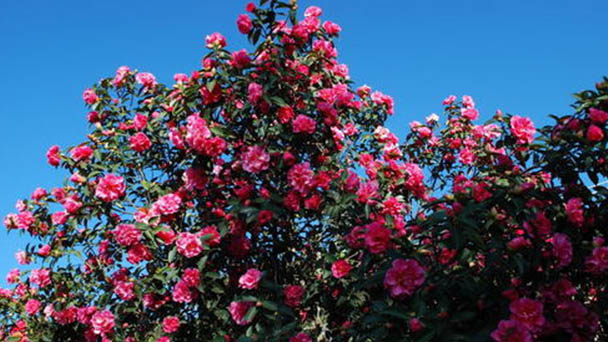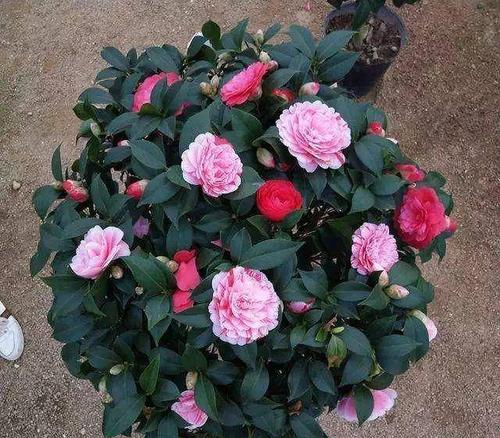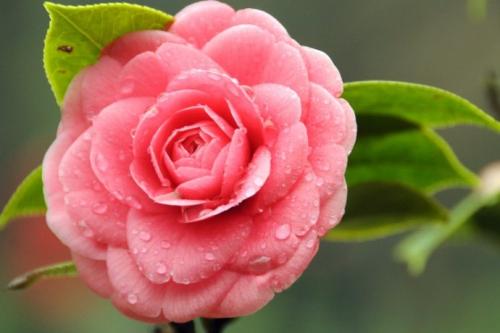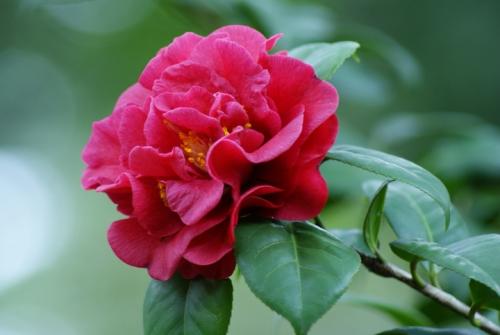Propagation methods of Japanese camellia
Written by Maggie
Jan 07 2021

There are many propagation methods of Japanese camellia, including sexual propagation and asexual propagation, among which cuttage and grafting are the most common.

Cuttage propagation method of Japanese camellia
Cuttage propagation method of Japanese camellia is the most simple, cutting time between September is the most suitable, and also can be in spring. Select well-grown, semi-lignified branches, remove the base leaves, keep the upper 3 leaves, cut into oblique mouth with a sharp knife, immediately dip the incision into 200 ~ 500ppm indolebutyric acid for 5 ~ 15 minutes, dry it and insert it into sand basin or vermiculite basin. After inserting, water the wound healing for 40 days and root for 60 days. After using hormone treatment, cutting roots was produced 2 ~ 3 months earlier than that without hormones. Using vermiculite as a slotting bed, it also roots much faster than a sand bed.
Connection propagation method of Japanese camellia
Choose suitable varieties such as tea cup or camellia as rootstock and follow the famous Japanese Camellia. It is usually between Tomb-sweeping Day and Mid-Autumn Festival. Plant the rootstock in a flowerpot, cut off about half of each section of the plant with a knife, and make smooth cuts. Then make the cut sides close together. Cover with plastic wrap and water the plant twice a day. Cut the plant and place it under the shade of a tree to avoid direct sunlight. In February of the following year, the end of the rootstock was cut off with a knife and replanted.
Leaf cutting propagation method of Japanese camellia
In general, leafy japanese camellia is used for propagation by cutting, but some rare species also adopt leaf cutting because of the limitation of the source of branches or because of the influence on the shape of the tree. Make cutting substrate with mountain mud, and it can mix into 1/3 of the river sand. In order to ventilation and drainage, substrate sheng in tile basin, and then basin inserted. Leaf insertion is best done in the rainy season, take annual leaves as leaf insertion material, too old, not easy to root, too tender, easy to rot. Insert about 2cm into the soil, press the soil tightly after inserting, pour enough water over it, and place it in a cool, well-ventilated place. Generally 3 months later, it can send a root, and in the 2nd year spring, it can sprout to pump a branch.

High interpolation propagation method of Japanese camellia
The greatest feature of the high interpolation propagation method of Japanese camellia is that it can give new life to the weak and weak branches that should be pruned away from Japanese Camellia. And the survival rate of this method is high, fast rejuvenation, early flowering. The method is: we need to trim off the thin branches, in place of girdling, (general upper branches can be retained 15 ~ 25 cm) ring strip length can be between 5 ~ 8 mm, bound and appropriate to the size of the plastic film. Membrane is added into the peat soil or leaf soil disinfection sterilization, 7 ~ 10 days later, at the bottom of the plastic film girdling 5 ~ 8 mm. This is called double loop shell high interpolation.
Tree grafting propagation method of Japanese camellia
Japanese Camellia is a plant that is difficult to survive. There are many ways to propagate Japanese Camellia, among which grafting is the most commonly used. Grafting Japanese camellia has many advantages: it can maintain the good traits of the variety; It can accelerate the growth of plants, make them shape quickly and produce on a large scale. Saving panicles, especially for those rare species with few panicle sources, which is especially important.
Grafting Japanese camellia on Camellia oleifera is as follows:
Grafting time
The grafting time should be between June and July, when the leaves of Japanese camellia new tip have been expanded, and the temperature is high, the grafting wound is healed quickly, and the survival rate is high.
Grafting method
Use the cutting method in the grafting method. Because of the higher part of the graft, we are often called "high grafting".
1. Rootstock treatment: There are two ways to treat rootstock. The first is to graft in June to July, choose 3 to 5 evenly distributed, diameter of 2 to 5 cm on Camellia oleifera as the grafting branch. With the hand saw grafting cuttings, a sharp grafting knife will be used to cut the saw mouth rough after grafting. Thicker branches can be joined along the periphery of several more scions. Second, in the winter of the previous year, select 3 to 5 evenly distributed main branches for cutting, indeterminate branches, each branch and then selected 3 to 5 indeterminate branches carefully preserved, between June and July to indeterminate branches after semi-ligneous grafting. This is also known as green branch grafting or grafting method.
2. Scion selection: On the selected mother tree admiring the Japanese camellia species, select the annual branches that grow in the upper part of the canopy and are healthy, disease-free, and have full eyes as the scion.
3. Grafting tools and auxiliary materials: packaging ropes, plastic thin strips, white plastic cover bags, cutting knives, pruning shears, hand saws, etc.
4. Specific operation steps of cutting: Cut the scion into 5 to 6 cm segments, with 2 to 3 side buds in each segment. To reduce evaporation, cut the leaves by half. Cut a long bevel about 2 to 3 cm long at 1 cm of the bud under the scion, and cut a short side on the opposite side of the long side, within 1 cm in length. Cut the cutting edge of the stock flat and cut it straight down at the xylem edge of the stock section. The length and width of the cut of the stock correspond to the long face of the scion. Then insert the long inclined face of the scion into the stock and align one side of the cambium.
Rootstock thick can be joined along the periphery of a few more scions, connected together after binding. Bind with 1 cm wide plastic thin film strip (due to certain elasticity) to bind, the film must be tensioned. After binding the rootstock, put a clear white plastic bag over it and tie the mouth of the bag with a wrapping rope to keep it moist. In places where the sun is too strong, the grafted plant should be treated for shading. During curing, the bud on rootstock should be erased at any time to reduce nutrient consumption.

Latest Updated
- Benefits of Bugleweed - 7 Science-backed Health Benefits
- Bugleweed Dangers & Side Effects - Is It Poisonous?
- How to Plant Evergreen Trees - What You Should Know
- When to Plant Evergreens - Grow Guide for Evergreen Trees
- 12 Wonderful Evergreen Shrubs for Your Garden
- 12 Popular Evergreen Plants with Pictures for Beginners
- When And How To Prune A Lilac Bush Like a Pro
- How to Grow & Care for Lilac Vine (Hardenbergia Violacea)
- Japanese Lilac Tree (Syringa Reticulata) Care & Propagation Guide
- Shumard Oak Pros and Cons - What to Know
Popular Articles
- Winter maintenance of Antirrhinum Majus
- How to Grow Terminalia Mantaly Tree
- How to Grow and Care for Crossostephium Chinense
- How to grow Antirrhinum Majus in spring
- Peristeria Elata (Dove Orchid) Profile: Info & Care Guide
- Underwatered Snake Plant (Sansevieria Trifasciata) - Signs And How To Fix
- How to Care for Brazilian Jasmine Plant (Mandevilla Sanderi)
- How to Grow & Care for Graptopetalum Purple Delight in Summer
- Rosa Chinensis (China Rose): Plant Growing & Care Tips
- How to Care for Baby Sun Rose (Aptenia Cordifolia)